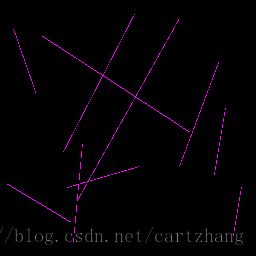openCV 和GDI画线效率对比
一、
由于项目需要,原来用GDI做的画线的功能,新的项目中考虑到垮平台的问题,打算用openCV来实现,故此做个效率对比。
二、
2点做一条线,来测试效率。
用了同样的画板大小---256*256的大小,函数通过参数输入,用GetTickCount来实现计时功能。
三、
GDI的主要循代码如下:
void show_line(int line_num,int point_num)
{
ULONAG start_time = get_tick_count();
VMGdiPolygon* test_polygon = new VMGdiPolygon();
int width = 256;
int height = 256;
test_polygon->VMIsCleanCloth();
test_polygon->VMGdiInitBuf(width,height);
COLORREF color = 0x0000FF;
test_polygon->VMGdiSetPenColor(color);
test_polygon->VMGdiSetPenWidth(2);
int rangle = width;
int line_count = line_num;
for (int i = 0; i < line_count;i++)
{
for (int j = 0; j<point_num;j++)
{
int x_1 = random_fun(rangle);
int y_1 = random_fun(rangle);
int x_2 = random_fun(rangle);
int y_2 = random_fun(rangle);
double pt_0[3] = {x_1,y_1,0};
double pt_2[3] = {x_2,y_2,0};
test_polygon->VMGdiLine(pt_0,pt_2);
}
//test_polygon->VMGdiLine(data,point_num,false);
}
ULONAG end_time = get_tick_count();
cout<<"start time"<<start_time<<"--->end time:"<<end_time<<endl;
cout<<"the number of "<<line_count<<" lines "<<"has "<<point_num<<" 个数"<<" takes "<<end_time-start_time<<"ms "<<endl;
test_polygon->VMGdiGetbitmap("D:\\001.bmp");
}
OpenCV的测试循环代码为:
void test_line(int width,int height,int line_count,int point_num,int line_width)
{
ULONAG start_time = get_tick_count();
int pic_width = width;
int pic_height = height;
Mat picture(pic_width,pic_height,CV_8UC4,Scalar(255,255,255));
int rangle = width;
for (int i = 0; i < line_count;i++)
{
for (int j = 0; j<point_num;j++)
{
int x_1 = random_fun(rangle);
int y_1 = random_fun(rangle);
int x_2 = random_fun(rangle);
int y_2 = random_fun(rangle);
//画线
Point a = Point (x_1,y_1);
Point center = Point(x_2,y_2);
//cout<<x_1<<" "<<y_1<<endl;
//参数为:承载的图像、起始点、结束点、颜色、粗细、线型
line(picture,a,center,Scalar(255,0,0),line_width,8);
}
}
ULONAG end_time = get_tick_count();
cout<<"the number of "<<line_count<<" lines "<<" takes "<<end_time-start_time<<"ms "<<endl;
imshow("底板",picture);
show_info(picture);
}
四、
调用过程有在main函数中设计线的条数和每条线点的格式。
时间对比:
生成的图表为:
结果对比:opencv的画线效率和GDI在1000个点的处理效率是一致的,用gettickcount使用时间的忽略不计的。
而在整体效率比较中,很明显opencv的画线效率更高。
五、
两种情况均保存成bmp格式图像。
效果对比:
放大效果:
OpenCV放大:
目前看来,opencv 处理效果较好点。
六、
两个main函数的代码
GDI main函数代码:
#include "VMGdiPolygon.h"
using namespace VRMap;
#include <iostream>
using namespace std;
#include "rw_timer.h"
int random_fun(int rangle);
void show_2_point_line();
void show_line(int line_num,int point_num,int line_width);
//void show_polygonline(int line_num,int point_num,int line_width);
void main()
{
//show_2_point_line();
int line_number = 1;
int point_numb = 10;
int line_width = 2;
show_line(line_number,point_numb);
//show_polygonline(line_number,point_numb,line_width);
system("pause");
return;
}
int random_fun(int rangle)
{
int seed(0);
int result = rand()%rangle;
return result;
}
void show_2_point_line()
{
VMGdiPolygon* test_polygon = new VMGdiPolygon();
int width = 256;
int height = 256;
test_polygon->VMIsCleanCloth();
test_polygon->VMGdiInitBuf(width,height);
double pt_0[3] = {0,0,0};
double pt_2[3] = {20,20,0};
COLORREF color = 0xFFFF00;
test_polygon->VMGdiSetPenColor(color);
test_polygon->VMGdiSetPenWidth(2);
test_polygon->VMGdiLine(pt_0,pt_2);
test_polygon->VMGdiGetbitmap("D:\\001.bmp");
}
void show_line(int line_num,int point_num)
{
ULONAG start_time = get_tick_count();
VMGdiPolygon* test_polygon = new VMGdiPolygon();
int width = 256;
int height = 256;
test_polygon->VMIsCleanCloth();
test_polygon->VMGdiInitBuf(width,height);
COLORREF color = 0x0000FF;
test_polygon->VMGdiSetPenColor(color);
test_polygon->VMGdiSetPenWidth(2);
int rangle = width;
int line_count = line_num;
for (int i = 0; i < line_count;i++)
{
for (int j = 0; j<point_num;j++)
{
int x_1 = random_fun(rangle);
int y_1 = random_fun(rangle);
int x_2 = random_fun(rangle);
int y_2 = random_fun(rangle);
double pt_0[3] = {x_1,y_1,0};
double pt_2[3] = {x_2,y_2,0};
test_polygon->VMGdiLine(pt_0,pt_2);
}
//test_polygon->VMGdiLine(data,point_num,false);
}
ULONAG end_time = get_tick_count();
cout<<"start time"<<start_time<<"--->end time:"<<end_time<<endl;
cout<<"the number of "<<line_count<<" lines "<<"has "<<point_num<<" 个数"<<" takes "<<end_time-start_time<<"ms "<<endl;
test_polygon->VMGdiGetbitmap("D:\\001.bmp");
}
openCV的main函数代码:
#include <stdio.h>
#include <stdlib.h>
#include <time.h>
using namespace std;
#include "rw_timer.h"
//
////
#pragma comment(lib,"opencv_ml249d.lib")
#pragma comment(lib,"opencv_calib3d249d.lib")
#pragma comment(lib,"opencv_contrib249d.lib")
#pragma comment(lib,"opencv_core249d.lib")
#pragma comment(lib,"opencv_features2d249d.lib")
#pragma comment(lib,"opencv_flann249d.lib")
#pragma comment(lib,"opencv_gpu249d.lib")
#pragma comment(lib,"opencv_highgui249d.lib")
#pragma comment(lib,"opencv_imgproc249d.lib")
#pragma comment(lib,"opencv_legacy249d.lib")
#pragma comment(lib,"opencv_objdetect249d.lib")
#pragma comment(lib,"opencv_ts249d.lib")
#pragma comment(lib,"opencv_video249d.lib")
#pragma comment(lib,"opencv_nonfree249d.lib")
#pragma comment(lib,"opencv_ocl249d.lib")
#pragma comment(lib,"opencv_photo249d.lib")
#pragma comment(lib,"opencv_stitching249d.lib")
#pragma comment(lib,"opencv_superres249d.lib")
#pragma comment(lib,"opencv_videostab249d.lib")
#pragma comment(lib,"opencv_objdetect249.lib")
#pragma comment(lib,"opencv_ts249.lib")
#pragma comment(lib,"opencv_video249.lib")
#pragma comment(lib,"opencv_nonfree249.lib")
#pragma comment(lib,"opencv_ocl249.lib")
#pragma comment(lib,"opencv_photo249.lib")
#pragma comment(lib,"opencv_stitching249.lib")
#pragma comment(lib,"opencv_superres249.lib")
#pragma comment(lib,"opencv_videostab249.lib")
#pragma comment(lib,"opencv_calib3d249.lib")
#pragma comment(lib,"opencv_contrib249.lib")
#pragma comment(lib,"opencv_core249.lib")
#pragma comment(lib,"opencv_features2d249.lib")
#pragma comment(lib,"opencv_flann249.lib")
#pragma comment(lib,"opencv_gpu249.lib")
#pragma comment(lib,"opencv_highgui249.lib")
#pragma comment(lib,"opencv_imgproc249.lib")
#pragma comment(lib,"opencv_legacy249.lib")
#pragma comment(lib,"opencv_ml249.lib")
#include<iostream>
#include <opencv2/core/core.hpp>
#include <opencv2/highgui/highgui.hpp>
using namespace cv;
int random_fun(int rangle);
void show_info(Mat picture);
void test_line(int width,int height,int line_count,int point_num,int line_width);
void test_polyline(int width,int height,int line_count,int point_num,int line_width);
int main()
{
int width = 256;
int height = 256;
int line_count = 100;
int point_num = 1000;
int line_width = 1;
test_line(width,height,line_count,point_num,line_width);
//
//test_polyline(width,height,line_count,100,line_width);
// 等待6000 ms后窗口自动关闭
waitKey(12000);
}
void show_info(Mat picture)
{
if (picture.data == NULL){
return;
}
//IplImage* test_img = cvSaveImage()
int channels = picture.channels();
int rows = picture.rows;
int cols = picture.cols;
uchar* data = picture.data;
cout<<"chanels:"<<channels<<" rows:" <<rows<<" cols:"<<cols<<endl;
}
void test_line(int width,int height,int line_count,int point_num,int line_width)
{
ULONAG start_time = get_tick_count();
int pic_width = width;
int pic_height = height;
Mat picture(pic_width,pic_height,CV_8UC4,Scalar(255,255,255));
int rangle = width;
for (int i = 0; i < line_count;i++)
{
for (int j = 0; j<point_num;j++)
{
int x_1 = random_fun(rangle);
int y_1 = random_fun(rangle);
int x_2 = random_fun(rangle);
int y_2 = random_fun(rangle);
//画线
Point a = Point (x_1,y_1);
Point center = Point(x_2,y_2);
//cout<<x_1<<" "<<y_1<<endl;
//参数为:承载的图像、起始点、结束点、颜色、粗细、线型
line(picture,a,center,Scalar(255,0,0),line_width,8);
}
}
ULONAG end_time = get_tick_count();
cout<<"the number of "<<line_count<<" lines "<<" takes "<<end_time-start_time<<"ms "<<endl;
imshow("底板",picture);
show_info(picture);
}
// 读入一张图片(游戏原画)
//Mat img=imread("pic.jpg");
//// 创建一个名为 "游戏原画"窗口
//cvNamedWindow("游戏原画");
//// 在窗口中显示游戏原画
//imshow("游戏原画",img);
int random_fun(int rangle)
{
int seed(0);
//srand( (unsigned)time( NULL ) );
int result = rand()%rangle;
return result;
}
void test_polyline(int width,int height,int line_count,int point_num,int line_width)
{
ULONAG start_time = get_tick_count();
int pic_width = width;
int pic_height = height;
Mat picture(pic_width,pic_height,CV_8UC4,Scalar(255,255,255));
line_count = 1;
int rangle = width;
Point** test_points = new Point*[line_count];
int *npts = new int[line_count];
for (int j = 0;j < line_count;j++)
{
Point rook_points[1][100];
for (int k =0;k<100;k++)
{
int x = random_fun(rangle);
int y = random_fun(rangle);
rook_points[0][j] = Point( x,y);
}
const Point* ppt[1] = { rook_points[0] };
int npt[] = { 100 };
polylines(picture,ppt,npt,1,1,CV_RGB(0,255,0),2,8,0);
}
imshow("底板",picture);
//
//for (int j = 0;j < line_count;j++)
//{
// delete []test_points[j];
// test_points[j] = NULL;
//}
//delete []test_points;
//test_points = NULL;
ULONAG end_time = get_tick_count();
cout<<"the number of "<<line_count<<" lines "<<" takes "<<end_time-start_time<<"ms "<<endl;
show_info(picture);
}
当然使用需要opencv的各种库的配置。opencv的下载和使用,可参考浅墨的http://blog.csdn.net/poem_qianmo/article/details/20911629
opencv教程和配置设置等博客。
源码免费下载地址:GDI测试代码
OPENCV的画线测试代码
-------------THE END--------------
若有问题,请不吝赐教。





